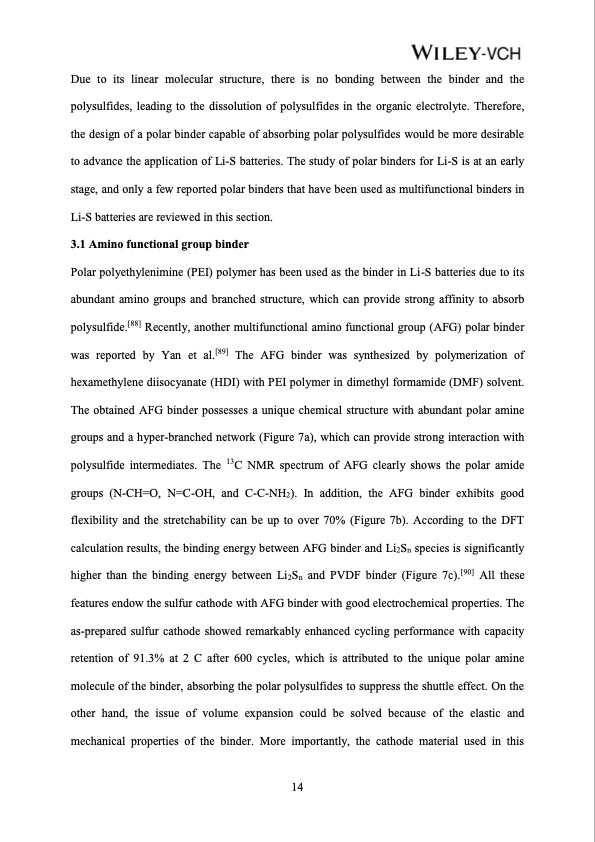
PDF Publication Title:
Text from PDF Page: 016
Due to its linear molecular structure, there is no bonding between the binder and the polysulfides, leading to the dissolution of polysulfides in the organic electrolyte. Therefore, the design of a polar binder capable of absorbing polar polysulfides would be more desirable to advance the application of Li-S batteries. The study of polar binders for Li-S is at an early stage, and only a few reported polar binders that have been used as multifunctional binders in Li-S batteries are reviewed in this section. 3.1 Amino functional group binder Polar polyethylenimine (PEI) polymer has been used as the binder in Li-S batteries due to its abundant amino groups and branched structure, which can provide strong affinity to absorb polysulfide.[88] Recently, another multifunctional amino functional group (AFG) polar binder was reported by Yan et al.[89] The AFG binder was synthesized by polymerization of hexamethylene diisocyanate (HDI) with PEI polymer in dimethyl formamide (DMF) solvent. The obtained AFG binder possesses a unique chemical structure with abundant polar amine groups and a hyper-branched network (Figure 7a), which can provide strong interaction with polysulfide intermediates. The 13C NMR spectrum of AFG clearly shows the polar amide groups (N-CH=O, N=C-OH, and C-C-NH2). In addition, the AFG binder exhibits good flexibility and the stretchability can be up to over 70% (Figure 7b). According to the DFT calculation results, the binding energy between AFG binder and Li2Sn species is significantly higher than the binding energy between Li2Sn and PVDF binder (Figure 7c).[90] All these features endow the sulfur cathode with AFG binder with good electrochemical properties. The as-prepared sulfur cathode showed remarkably enhanced cycling performance with capacity retention of 91.3% at 2 C after 600 cycles, which is attributed to the unique polar amine molecule of the binder, absorbing the polar polysulfides to suppress the shuttle effect. On the other hand, the issue of volume expansion could be solved because of the elastic and mechanical properties of the binder. More importantly, the cathode material used in this 14PDF Image | Advances in Polar Materials for Lithium-Sulfur Batteries

PDF Search Title:
Advances in Polar Materials for Lithium-Sulfur BatteriesOriginal File Name Searched:
212718644.pdfDIY PDF Search: Google It | Yahoo | Bing
Sulfur Deposition on Carbon Nanofibers using Supercritical CO2 Sulfur Deposition on Carbon Nanofibers using Supercritical CO2. Gamma sulfur also known as mother of pearl sulfur and nacreous sulfur... More Info
CO2 Organic Rankine Cycle Experimenter Platform The supercritical CO2 phase change system is both a heat pump and organic rankine cycle which can be used for those purposes and as a supercritical extractor for advanced subcritical and supercritical extraction technology. Uses include producing nanoparticles, precious metal CO2 extraction, lithium battery recycling, and other applications... More Info
| CONTACT TEL: 608-238-6001 Email: greg@infinityturbine.com | RSS | AMP |